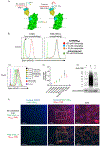Rapid Covalent Labeling of Membrane Proteins on Living Cells Using a Nanobody-Epitope Tag Pair
- PMID: 36107739
- PMCID: PMC10200341
- DOI: 10.1021/acs.bioconjchem.2c00334
Rapid Covalent Labeling of Membrane Proteins on Living Cells Using a Nanobody-Epitope Tag Pair
Abstract
Synthetic molecules that form a covalent bond upon binding to a targeted biomolecule (proximity-induced reactivity) are the subject of intense biomedical interest for the unique pharmacological properties imparted by irreversible binding. However, off-target covalent labeling and the lack of molecules with sufficient specificity limit more widespread applications. We describe the first example of a cross-linking platform that uses a synthetic peptide epitope and a single domain antibody (or nanobody) pair to form a covalent linkage rapidly and specifically. The rate of the cross-linking reaction between peptide and nanobody is faster than most other biocompatible cross-linking reactions, and it can be used to label live cells expressing receptor-nanobody fusions. The rapid kinetics of this system allowed us to probe the consequences on signaling for ligand cross-linking to the A2A-adenosine receptor. Our method may be generally useful to site-specifically link synthetic molecules to receptors on mammalian cell surfaces.
Conflict of interest statement
Figures




References
Publication types
MeSH terms
Substances
Grants and funding
LinkOut - more resources
Full Text Sources

